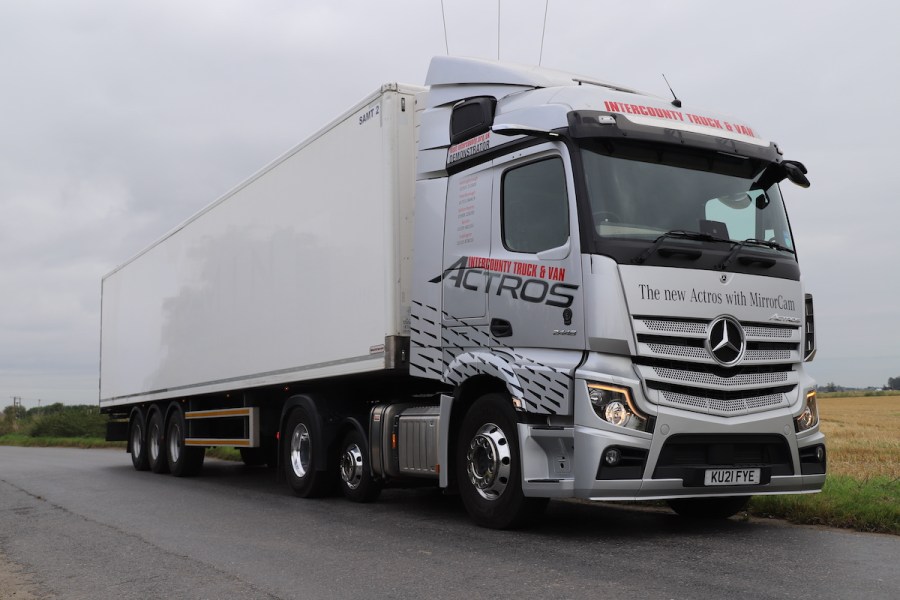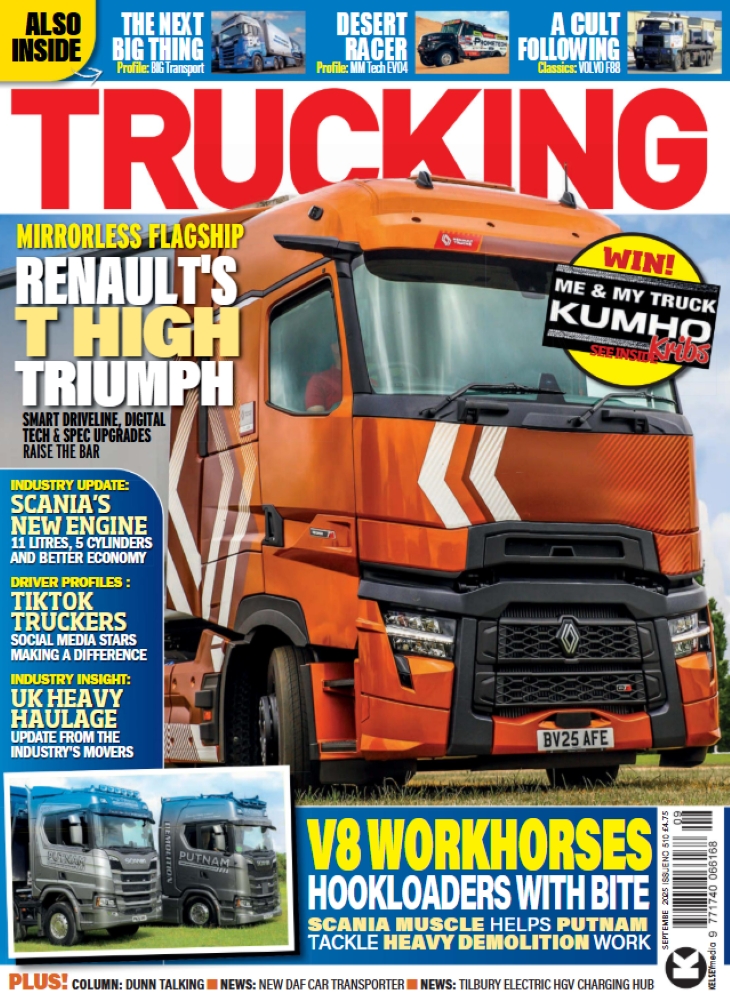The no-frills, high-earning potential fleet tractor often gets overlooked – but Mercedes has plenty of choice in that sector. We took an Actros 2448 out for a couple of days to see what is (and isn’t) good about it, and why you should consider it…
There’s a driver shortage, yes? And one of the ways to attract and retain good drivers is surely to give them a good truck with the biggest cab and biggest engine?
Well, yes, to a degree that works – but the best way to appeal to drivers is through their pay packet. But increasing wages, as so many hauliers have had to do of late, means you need to make savings elsewhere or put up the rates.
To give drivers more money and save on fuel, buying a big-engined truck is simply no longer the answer for many sensible hauliers, especially those with small fleets of 10 or so trucks. Fleet-spec vehicles are the answer; if your driver is given the choice of fleet truck and more wages or a throbbing V8 and minimum wage, we reckon they’ll go for the former!
The Merc under our microscope in this test is a quintessential bread-and-butter gaffer’s motor. It’s no-frills, but more than competent as it’ll do any job asked of it. The question is, even as a fleet truck, does it make the grade? To find out, we put it to work for a couple of days for two full shifts, with a mix of loaded and unloaded runs and plenty of manoeuvring to boot.
Technical overview
The ‘24’ part of the 2448 badge tells you the truck has the small midlift axle ahead of the drive axle (a standard 6×2 would be a ‘25’). These still look a bit weird, or even borderline flimsy (they are not), and some drivers simply do not like the look of them. However, they offer typically half a tonne at least off the weight of the tractor, which can of course be put to better use as payload.
The ‘48’ part of the badge tells you under the cab is Merc’s OM471 12.8-litre straight-six at 476 bhp. Many fleet operators prefer the 449 bhp 2445 or 2545 models, but we’ve always found this engine a little laboured and afraid of hills. Even the 2546 (tested back in Trucking issue 455) at 456 bhp from a 10.7-litre OM470 engine is much superior to the 2545. The 476 bhp lump is certainly a better bet, and we’d choose it for a fleet Merc ahead of the ‘45’ models any time – even when not maxing out a 44-tonnes all too often.
The cab on our truck was the narrow, 2.3 m wide, three-step StreamSpace with a medium-height sleeper and 170 mm engine hump. We won’t bore you with the alternative cab options because Mercedes has hundreds of them, but it’s neither the smallest height, smallest high roof, nor the largest. Put it this way: it’s no GigaSpace, but it’s not really a ‘Wendy house’ either. It’s a cab that’s fine for overnighting maybe once or twice in the week, but any more – especially on a regular basis – might have your driver asking for a bigger cab.
This StreamSpace is well-appointed, comfortable and it has all the benefits of a sleeper cab – better residual value, more room for the driver’s stuff, the ability for them to have a nap when held up. Merc has some of the better cabs on the market, although we think it is now being overtaken by its arch German rival, MAN. Indeed, with new DAFs and facelifted Volvos, Renaults and Scanias all now available, Merc’s cab – which in this Version 5 form is now still only three years old – is slowly dropping down the desirability league table. That said, it’s still a fine place to work.
On the road
The 2448 understandably had MirrorCam and the Multimedia Cockpit and we like both, especially now we are getting increasingly familiar with them at every drive.
One question often levied at MirrorCam is: what happens if the camera arm gets whacked? Well, on this test we found out, as a tree branch did just that. We lost the correct view on left-hand screen; so when safe to do so we stopped, put on the hazards, walked across the cab, opened the window and folded the arm back into place. Rear vision was restored, just the same as how you’d fix a conventional mirror. The question is: would the tree have smashed the glass in a mirror? It certainly didn’t damage the camera arm.
There are of course pros and cons with MirrorCam. One thing we like is when you are on the bunk resting and you want to look around your truck, you can flick a switch to turn on the cameras from the comfort of your bed. That switch, however, is an option – and if you don’t have it, then a particularly annoying scenario is when you are on a bay, sat on the bunk waiting for the dreaded red light to go green, and the camera turns off. You can’t just glance up; you have to get up, head to the seat and press the button on the door. Also, the view of the bay light is not as bright or as clear as we’d like; and MirrorCam is awkward in the bright sun – but you can levy the latter criticism at a conventional wing mirror.
The truck handled very well and 476 bhp is fine for most terrains (if it’s not, there’s plenty of choice for more grunt). It is a little slow when pulling away when there is a decent load on the back, but it’s not a big issue.
There is inadequate movement in the steering wheel when getting in and out of the truck, and Merc surely can’t be too far off copying Scania, MAN and others in offering a moveable steering wheel that properly moves out of your way when required.
The electronic parking brake remains controversial. We found it a pain at times, and occasionally it simply would not come off. That might be due to driver ignorance, but it was annoying. The fifth wheel on our model was set a bit too far forward, making it nigh-on impossible to get in between the cab and the trailer (with fridge engine) to attach the susies. Instead, we had to back under, couple the airlines and then push back further to catch the pin and make it couple properly. That’s not a criticism of the Merc as such, just set-up.
The Multimedia touch screen remains a bit of a work-in-progress, especially when on the move. It was especially annoying when changing radio station. And one thing we found infuriating was the two cup holders – one was too small, the other too big! We ended up having to wedge our flask in with a napkin. It’s a small point, but adjustable cup holders would be much better.
On the whole, we find Predictive Cruise Control pretty good, but you need to know how to get the best out of it to really make it worthwhile. Once you get the hang of it and understand its quirky features, it’s pretty impressive.
Verdict
If we are honest, a true Merc fleet motor should have the smaller cab – like on the 2546 we tested a few issues back. Both have three-step entry, but the 2448 is still a bit of a climb to get into, which can be an issue if you are in and out of the cab regularly during the day.
But this 2448 has a lot going for it. It has enough power, the cab is roomy enough and certainly a lovely place for a day’s drive – and not at all bad for a night out either.
MirrorCam has far more plusses than minuses. It could be improved, but remember: Merc pioneered this system and now it’s being copied by just about everyone else the concept is sound. We’re sure MirrorCam V2 is already well in development.
While they do not look nice, small midlift axles offer better payload and are cheaper to buy. If they offend you that much, you can cover them with sideskirts on a Merc.
The Mercedes range is usually competitively priced and residuals are consistently good. Fuel returns are also impressive enough; not the best in the field, but they are well up there.
So in short, this truck ticks a lot of boxes and should appeal to most operators. If it’s earning them more money, then some of it can trickle down into the driver’s pay packet.
This Mercedes is a serious proposition for many applications. If you are after a no-frills fleet truck, it fulfils the brief very well indeed.
We like
- A very good fleet truck
- Good payload capability
- Good build quality
- MirrorCam
We don’t like
- Some important features are only options
- Electric parking brake






